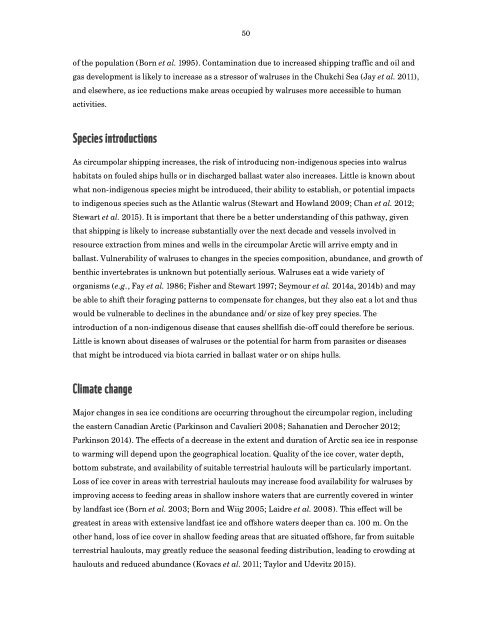The State of Circumpolar Walrus Populations
walrusreport
walrusreport
You also want an ePaper? Increase the reach of your titles
YUMPU automatically turns print PDFs into web optimized ePapers that Google loves.
50<br />
<strong>of</strong> the population (Born et al. 1995). Contamination due to increased shipping traffic and oil and<br />
gas development is likely to increase as a stressor <strong>of</strong> walruses in the Chukchi Sea (Jay et al. 2011),<br />
and elsewhere, as ice reductions make areas occupied by walruses more accessible to human<br />
activities.<br />
Species introductions<br />
As circumpolar shipping increases, the risk <strong>of</strong> introducing non-indigenous species into walrus<br />
habitats on fouled ships hulls or in discharged ballast water also increases. Little is known about<br />
what non-indigenous species might be introduced, their ability to establish, or potential impacts<br />
to indigenous species such as the Atlantic walrus (Stewart and Howland 2009; Chan et al. 2012;<br />
Stewart et al. 2015). It is important that there be a better understanding <strong>of</strong> this pathway, given<br />
that shipping is likely to increase substantially over the next decade and vessels involved in<br />
resource extraction from mines and wells in the circumpolar Arctic will arrive empty and in<br />
ballast. Vulnerability <strong>of</strong> walruses to changes in the species composition, abundance, and growth <strong>of</strong><br />
benthic invertebrates is unknown but potentially serious. <strong>Walrus</strong>es eat a wide variety <strong>of</strong><br />
organisms (e.g., Fay et al. 1986; Fisher and Stewart 1997; Seymour et al. 2014a, 2014b) and may<br />
be able to shift their foraging patterns to compensate for changes, but they also eat a lot and thus<br />
would be vulnerable to declines in the abundance and/or size <strong>of</strong> key prey species. <strong>The</strong><br />
introduction <strong>of</strong> a non-indigenous disease that causes shellfish die-<strong>of</strong>f could therefore be serious.<br />
Little is known about diseases <strong>of</strong> walruses or the potential for harm from parasites or diseases<br />
that might be introduced via biota carried in ballast water or on ships hulls.<br />
Climate change<br />
Major changes in sea ice conditions are occurring throughout the circumpolar region, including<br />
the eastern Canadian Arctic (Parkinson and Cavalieri 2008; Sahanatien and Derocher 2012;<br />
Parkinson 2014). <strong>The</strong> effects <strong>of</strong> a decrease in the extent and duration <strong>of</strong> Arctic sea ice in response<br />
to warming will depend upon the geographical location. Quality <strong>of</strong> the ice cover, water depth,<br />
bottom substrate, and availability <strong>of</strong> suitable terrestrial haulouts will be particularly important.<br />
Loss <strong>of</strong> ice cover in areas with terrestrial haulouts may increase food availability for walruses by<br />
improving access to feeding areas in shallow inshore waters that are currently covered in winter<br />
by landfast ice (Born et al. 2003; Born and Wiig 2005; Laidre et al. 2008). This effect will be<br />
greatest in areas with extensive landfast ice and <strong>of</strong>fshore waters deeper than ca. 100 m. On the<br />
other hand, loss <strong>of</strong> ice cover in shallow feeding areas that are situated <strong>of</strong>fshore, far from suitable<br />
terrestrial haulouts, may greatly reduce the seasonal feeding distribution, leading to crowding at<br />
haulouts and reduced abundance (Kovacs et al. 2011; Taylor and Udevitz 2015).


